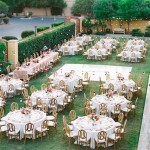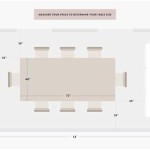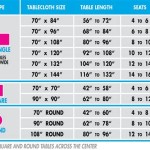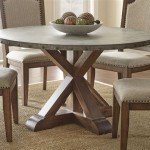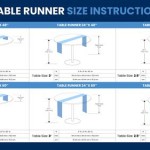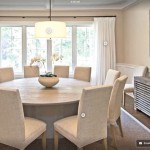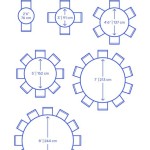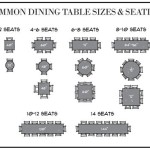```html
What Shape Table Is Best For Small Spaces?
Selecting the appropriate table shape for a compact living area is a critical decision that significantly impacts both functionality and aesthetics. The limitations imposed by smaller square footage necessitate a careful consideration of various table shapes, each offering distinct advantages and disadvantages in terms of space utilization, seating capacity, and overall room flow. This article will examine the common table shapes available and analyze their suitability for maximizing space in confined environments.
Round Tables: Optimizing Circulation and Social Interaction
Round tables are often recommended for smaller spaces due to their inherent ability to promote a sense of openness and facilitate smoother traffic flow. The absence of sharp corners minimizes obstruction, reducing the likelihood of bumping into the table and allowing for easier movement around the room. This is particularly beneficial in areas where space is at a premium and frequent navigation is required.
The circular design also encourages conversation and interaction among individuals seated around the table. Everyone is equidistant from the center, fostering a more inclusive and communal dining or working experience. This arrangement is conducive to both formal and informal gatherings, promoting a sense of togetherness that can be particularly appealing in smaller living environments.
However, round tables can present challenges when it comes to maximizing seating capacity. While a larger diameter round table can accommodate more individuals, it can also consume a significant amount of floor space. Finding the right balance between seating capacity and space utilization is crucial when considering a round table for a small area. Furthermore, the lack of straight edges can make it difficult to push the table against a wall for space-saving purposes, potentially limiting its versatility. Another consideration is that placing a round table against a wall can create an awkward and unbalanced aesthetic.
Considerations for furniture placement around a round table include ensuring sufficient clearance for chairs to be pulled out and for individuals to move freely. Rug size and shape should complement the table's circular form, avoiding the common mistake of using a rectangular rug that clashes with the table's curvature.
Square Tables: Balancing Formality and Spatial Efficiency
Square tables offer a sense of formality and structure that can be appealing in certain design schemes. Their straight lines and defined corners create a clean and organized aesthetic, contributing to a sense of order and control within a small space. This is particularly relevant in minimalist or modern design styles where clean lines and geometric shapes are emphasized.
Small square tables can be effectively utilized in corners or against walls, maximizing space utilization along the perimeter of the room. This flexibility makes them suitable for areas where space is severely limited. When placed against a wall, a square table effectively transforms into a console table, providing a surface for decorative items or storage without encroaching unnecessarily into the room's central space.
However, square tables can present challenges in terms of seating capacity and social interaction. A small square table typically accommodates only four individuals, limiting its suitability for larger gatherings. Furthermore, the defined corners can create a sense of separation among those seated around the table, potentially hindering conversation and creating a less inclusive atmosphere.
If considering a square table in a small space, it is crucial to choose a size that is proportionate to the room's dimensions. An overly large square table can quickly overwhelm the space, making it feel cramped and uncomfortable. Opting for a smaller square table and complementing it with additional seating options, such as foldable chairs or stools, can provide flexibility for accommodating guests without permanently sacrificing valuable floor space.
Rectangular Tables: Versatility with Strategic Placement
Rectangular tables, while generally considered more suitable for larger spaces, can be effectively integrated into smaller environments with careful planning and strategic placement. Their elongated shape allows for maximizing seating capacity along the sides, making them ideal for accommodating a larger number of individuals within a relatively confined area. This is particularly beneficial in dining areas where frequent gatherings are anticipated.
The linear design of rectangular tables allows for easy placement against walls, effectively transforming them into console tables or workspaces when not in use for dining or other activities. This versatility makes them a practical choice for multi-functional spaces where furniture must serve multiple purposes. Furthermore, the straight edges create a clean and organized aesthetic that complements various design styles.
However, rectangular tables can present significant challenges in small spaces due to their potential to obstruct traffic flow. The long, straight sides can create narrow passageways, making it difficult to navigate around the room. This is particularly problematic in areas where space is already limited and frequent movement is required.
Careful consideration must be given to the table's dimensions to ensure that it does not overwhelm the space or impede movement. Opting for a narrower rectangular table can help to minimize obstruction and maintain a sense of openness. Additionally, strategic placement is crucial. Positioning the table along a wall or in a corner can help to maximize space utilization and minimize its impact on traffic flow. Consider using benches along one side of the table instead of chairs to further reduce the space required for seating.
Oval Tables: A Hybrid Approach
Oval tables offer a compromise between the space-saving advantages of round tables and the seating capacity of rectangular tables. The rounded ends eliminate sharp corners, promoting smoother traffic flow and reducing the likelihood of bumping into the table. At the same time, the elongated shape allows for accommodating more individuals than a round table of comparable size.
The oval shape fosters a sense of inclusivity, similar to round tables, as it allows for easier eye contact and conversation among those seated around the table. This makes them suitable for both formal and informal gatherings, promoting a sense of togetherness in smaller living environments.
However, oval tables can be more challenging to find than round or rectangular tables, potentially limiting design options. They also do not fit as neatly against walls as rectangular or square tables, potentially sacrificing some space-saving potential. The unique shape can also make it more difficult to find complementary rugs and other furniture pieces that seamlessly integrate with the table's design.
When considering an oval table, it is crucial to carefully measure the available space and select a table size that is proportionate to the room's dimensions. Ensure that there is sufficient clearance for chairs to be pulled out and for individuals to move freely around the table. Lighting is also an important consideration. A central pendant light or chandelier can effectively illuminate the table and create a focal point in the room.
Ultimately, the best table shape for a small space depends on individual needs, preferences, and the specific characteristics of the room. Careful consideration of the factors outlined above will enable informed decision-making, resulting in a functional and aesthetically pleasing living environment.
```
So What Is The Best Shape Of Dining Table For A Small Space First You Need To Take Into Consi Sizes Simple
/mall/file/2022/05/27/94b7a9331c5624a5d8480b8951165197.jpg?strip=all)
Solved The Best Shape Table For A Small Space Bloom In Black

Solved The Best Shape Table For A Small Space Bloom In Black

Which Dining Table Shape Is Best For Me Round Square Odd

What Is The Best Shape Dining Table For A Small Space

Find The Perfect Dining Table In Five Simple Steps Mydeal

13 Small Dining Room Ideas And Decorating Tricks

Rules Of Thumb For Rugs Under Round Dining Tables Inspiration

The 7 Best Dining Tables And How To For One Reviews By Wirecutter

13 Small Dining Room Ideas And Decorating Tricks
Related Posts

